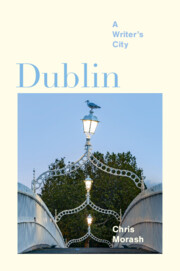Book contents
- Dublin
- Imagining Cities
- Dublin
- Copyright page
- Dedication
- Contents
- A Writer’s City: Series Preface
- Chronology
- Additional material
- Introduction The Imagined City in Time of Pandemic
- 1 Mapping the City
- 2 Baggotonia
- 3 Around St. Stephen’s Green
- 4 Trinity College
- 5 Around the Liberties
- 6 O’Connell Street and the Abbey Theatre
- 7 The North Inner City
- 8 South Dublin
- 9 The South Coast
- 10 North Dublin
- 11 Riverrun
- Read On …
- Notes
- Bibliography
- Acknowledgements
- Index
- Plate Section
6 - O’Connell Street and the Abbey Theatre
Published online by Cambridge University Press: 16 February 2023
- Dublin
- Imagining Cities
- Dublin
- Copyright page
- Dedication
- Contents
- A Writer’s City: Series Preface
- Chronology
- Additional material
- Introduction The Imagined City in Time of Pandemic
- 1 Mapping the City
- 2 Baggotonia
- 3 Around St. Stephen’s Green
- 4 Trinity College
- 5 Around the Liberties
- 6 O’Connell Street and the Abbey Theatre
- 7 The North Inner City
- 8 South Dublin
- 9 The South Coast
- 10 North Dublin
- 11 Riverrun
- Read On …
- Notes
- Bibliography
- Acknowledgements
- Index
- Plate Section
Summary
More than a century on, the modern history of Dublin continues to be dominated by the Easter Rising of 1916. Although the Rising took place all over the city, its focal point was the General Post Office, on O’Connell Street. This chapter takes as its keynote a paradox that emerges in the literature of O’Connell Street. On the one hand, it is here that a rebellion led by poets and playwrights has produced a site with a solemn historical memory attached to it. At the same time, the street itself has long had a carnivalesque quality, made possible by its original design as a place in which fashionable citizens could promenade, and continuing today. This tension emerges in major works by Samuel Beckett, James Joyce, Seán O’Casey, and W. B. Yeats, as well as by more recent writers, including Roddy Doyle. The sense of paradox is heightened by the proximity of the Abbey Theatre, on the adjacent Abbey Street. Here, a living theatre culture carries on a tradition begun by Yeats and Lady Gregory in 1904, contributing to the distinctive character of this part of the city as a kind unruly ceremonial centre.
- Type
- Chapter
- Information
- DublinA Writer's City, pp. 120 - 141Publisher: Cambridge University PressPrint publication year: 2023

